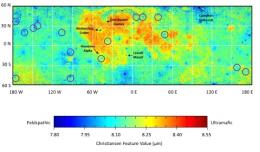The Rheic Ocean
Submitted by Joseph Menkhaus on Fri, 11/23/2007 - 11:49.
Stories like this one make me envious of Geologists who actually make a living studying this stuff...
Scientists reveal secrets of ancient ocean in new book

The Rheic Ocean separated two major land masses 430 million years ago. Art by: Christina Ullman, Ullman Design
Call it the ocean that time forgot. About 400 million years ago, the Rheic Ocean played a big role in Earth’s history. When this massive body of water closed, the Appalachians were lifted to Himalayan heights and the planet’s continents slammed together to form the supercontinent of Pangaea. Dinosaurs and early mammals evolved to traverse the large swath of land, spreading life to every corner of the globe.
|
Bumper Stickers... (Geology Humor)
Seen in the KSU Geology Department back in 1975..... "Reunite Gondwanaland (now called Gondwana)" (http://en.wikipedia.org/wiki/Gondwana).
...and seen in Wyoming in 1993..... "Free Sue" (Sue, the T. Rex who is currently in the Field Museum in Chicago, was "arrested" and was being held by the FBI, because the people who found her, dig her up, and did all the lab preparation on her were accused of "wrong doing" in how they purchased her from the landowner. (http://www.bhigr.com/pages/info/info_sue_5.htm).
Vertebrate Paleontology Blog (Like Dinosaurs & Stuff)
(Dr.) Michael Ryan is the (fairly) new Curator of Vertebrate Paleontology at the Cleveland Museum of Natural History.
This profession can be a dry and boring field, unless the person practicing it is as active and energenic as Michael (not "Mike).
Michael maintains a wonderful blog with lots of photos of his recent field work in Alberta, Canada, and in Mongolia, as well as excerpts from vintage dinosaur comic books and historical notes as well....
He has been a wonderful addition to the staff at the CMNH, and says that he is planning on expanding their current collection of dinosaur, for all visitors to see.
Here is his blog: http://palaeoblog.blogspot.com/
Enjoy...
Pangea 250 million years from now???
Pangaea Ultima: Climbing the Mediterranean Mountains
this what will become of the Earth’s surface?” asks the entry for 22 September 2007 of Astronomy Picture of the Day, a website affiliated with Nasa (judging from its url).“The surface of the Earth is broken up into several large plates that are slowly shifting. About 250 million years ago, the plates on which the present-day continents rest were positioned quite differently, so that all the landmasses were clustered together in one supercontinent now dubbed Pangea*. About 250 million years from now, the plates are again projected to reposition themselves so that a single landmass dominates. The above simulation from the Palaeomap Project shows this giant landmass: Pangea Ultima**. At that time, the Atlantic Ocean will be just a distant memory, and whatever beings inhabit Earth will be able to walk from North America to Africa.”
*: or Pangaea, in a more conservative spelling. This name for the supercontinent that existed around the Palaeozoic and Mesozoic eras was first used by Alfred Wegener in his 1920 book Die Entstehung der Kontinente und Ozeane (’The Origin of Continents and Oceans’), in which he first proposed the theory of continental drift.**: or Pangaea Ultima, translatable as ‘the ultimate unified landmass’. The remaining sole body of water can then be dubbed Panthalassa Ultima. This map was sent in by Jenn Berg.
From: http://strangemaps.wordpress.com/2007/12/04/213-pangaea-ultima-climbing-the-mediterrranean-mountains/ (Includes an interesting map)